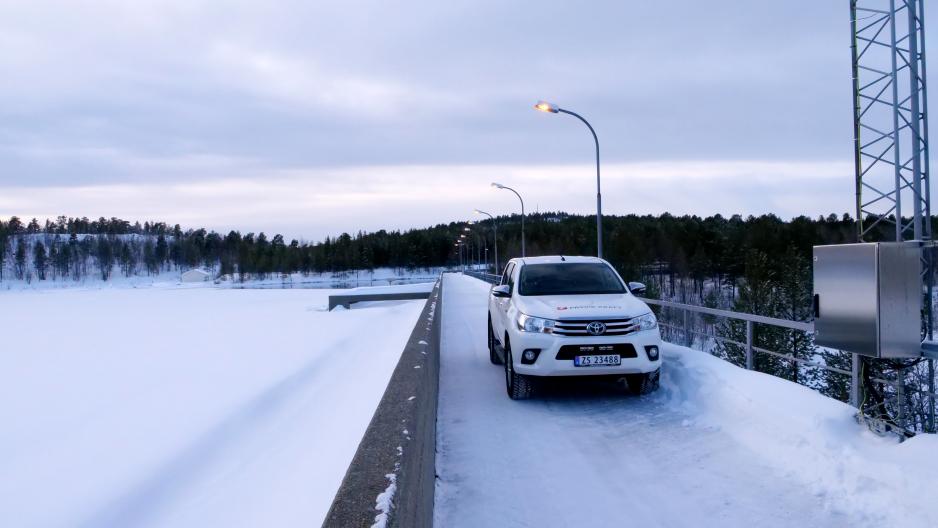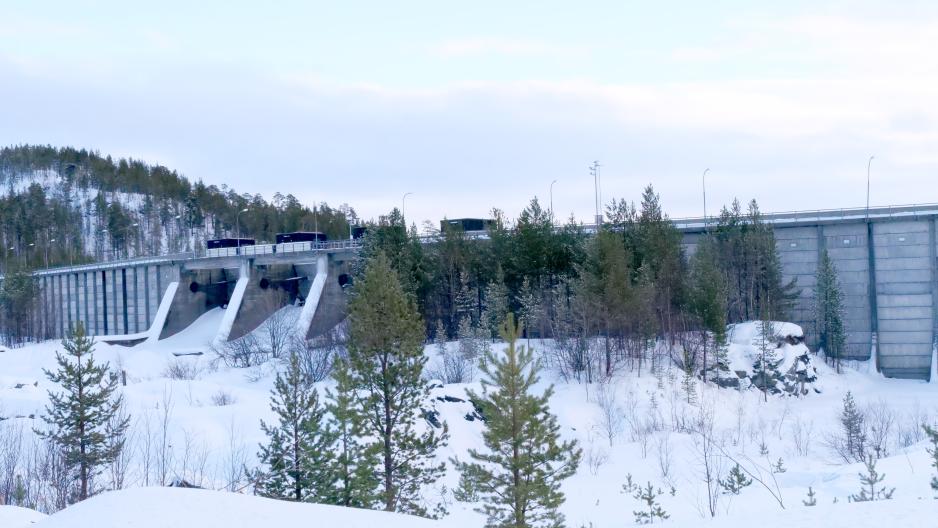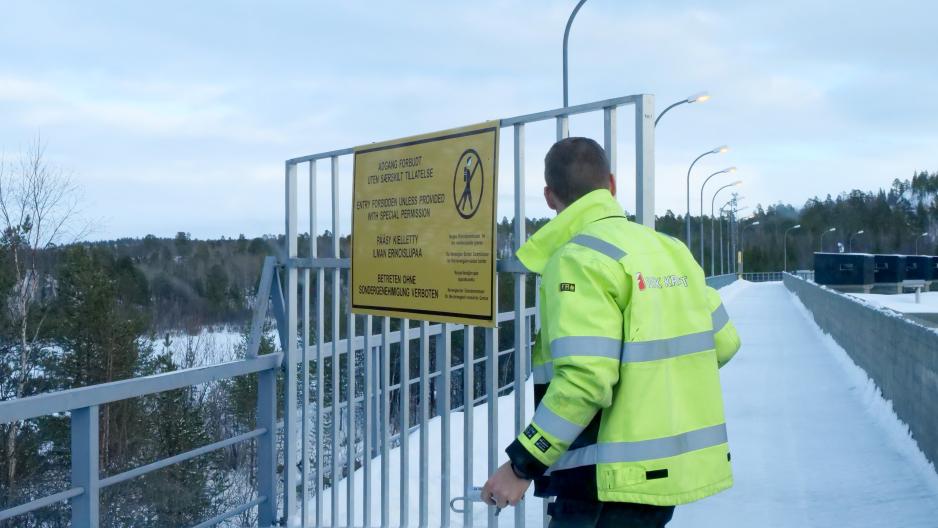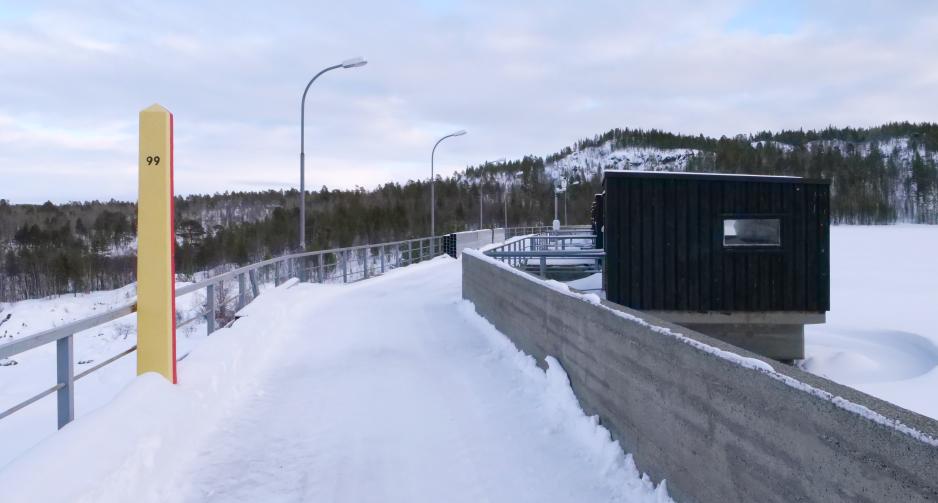Arne O. Holm: Here, Russia Could Cut Off Eastern Finnmark's Power

Here, but no further. The border between Russia and Norway runs in the middle of the Skogfoss dam. One meter behind Kristian Lande, who is employed at Skogfoss Power Station, lies Russian territory. (Photo: Arne O. Holm)
Skogfoss (High North News): Eastern Finnmark is at the center of a serious energy crisis. However, what few people know and even fewer wants to talk about is that Russia controls 1/4 of the energy supply on the Norwegian side. No one wants to answer what will happen if Russia decided to turn off the lights in Finnmark.
The situation worries the leaders of Varanger Kraft.
The transmission capacity of Eastern Finnmark is already exhausted. The existing grid is old and partly dilapidated.
This is serious
A few weeks ago, the CEO of Varanger Kraft, Terje Skansen, took the stage during the annual Kirkenes Conference, a meeting place for politics and businesses on the border with Russia.
"This is serious," he began and looked out on a full hall at Thon Hotell in Kirkenes, Northern Norway.
"As long as we do not have the grid capacity to develop anything, people will move. The grid is completely exhausted and if a small industrial business applies for connection to the grid, it will be rejected," the CEO continued.

Pasvik kraft's service cars are still allowed to turn on the Russian side as they inspect the dam. With a journalist onboard, it must back up to Norway. (Photo: Arne O. Holm)
Terje Skansen has fought a yearlong battle for the development of the power grid in Finnmark, Northern Norway. In Kirkenes on this Thursday in February, he elaborated on the worry in a meeting with state concession authorities. They are the ones who decide whether Skansen receives approval to build a 420kV powerline from west to east in Finnmark.
The Ministry of Petroleum and Energy does not want to answer when the decision will be made.
What Terje Skansen did not speak about, was that large parts of Finnmark's power supply are in reality in the hands of belligerent Russia.
The explanation for this lies a one-hour drive away from Kirkenes.
Large parts of the road follow the Pasvik River, which also marks the border between Norway and Russia.
The vulnerability is extreme.
A part of everyday life
On the way to Skogfoss, a small village 60 kilometers south of Kirkenes, I pass the Garrison of Sør-Varanger (GSV), a garrison with the responsibility of guarding the border between Norway and Russia. Later, I also pass Pasvikkompaniet at Svanhovd, a military unit with special responsibility for the area from Bjørnevatn to Treriksrøysa.
For those who live in Eastern Finnmark, civil and military preparedness is a part of everyday life. Now, also a reminder that the neighbor on the other side of the Pasvik River is waging a bloody and brutal war against another neighboring country.
As I drive, the distance between the houses gets longer. At one point, I pass the place where the Russian defector Andrej Medvedev suddenly and unexpectedly showed up on the Norwegian side of the Pasvik River the night of the 13th of January this year.
The dense taiga hides the border drives most of the drive, but it shows up when I near the destination of my journey, Skogfoss in Sør-Varanger municipality. The border station between the two countries was located here until it was moved to Svanhovd in 2014.
The Skogfoss dam
After a longer construction period, closely monitored by both Russian and Norwegian intelligence, Skogfoss Power Station started its operations in 1964. The power station itself is located by a canal blasted out of the mountain. From the Skogfoss dam, the water is led through the turbines, before it flows back to the Pasvik River below the power plant.
A narrow road, shut with a heavy steel gate, winds a couple of hundred meters below the power station and up to the dam.
Christian Lande, who has returned home to Pasvik after a few years in Svalbard – he missed the forest, unlocks another gate on the Norwegian side of the dam.
Exactly here, the river is 300 meters wide. The border between Norway and Russia apparently follows the middle of the river. It is still not quite right. The border runs where it is deepest and this varies over the years. According to the border agreement, the border will therefore be adjusted every 25 years.
Here, but no further
Lande maneuvers the power company's pickup out and drives to the middle of the Skogfoss dam.
Here, but no further.
The rest of the dam is on the Russian side.
Russia controls 1/4 of the power consumption in Finnmark.
Not just the rest of the dam. The hatches, three in total, which regulate the water supply to the power plant, are all located on the Russian side.
Right below the dam, on both sides of the river, are the official border markers. In the middle of a dam, a more symbolic, but important border marker. It marks where on the dam the divide between Norway and Russia is.
Further down the river lies Melkefossen, which together with Skogfoss, makes Pasvik KRaft, which again is owned by Varanger Kraft.
Before I drove to Skogfoss, I met Monica Jerijærvi. For 20 years, she has been the director of Pasvik Kraft.
Russia's warfare against Ukraine has given her and Terje Skansen new concerns on behalf of both businesses and inhabitants of Eastern Finnmark.
Serious concerns.
Power supply in danger
The concern is that Russia will exploit the tense situation and put the power supply in Eastern Finnmark in danger.
"If Russia wants to, they can make a lot of trouble," says Jerijærvi hesitantly.
"The dams are especially vulnerable," she adds.
State infrastructure hinders the security of supply.
I can see that for myself as I stand out on the dam. Not only are the hatches that in reality regulate the energy production located on the Russian side.
An earthen dam can also be found on the Russian side, the Mennika dam, which directs the flow of water from the Pasvik River into the Skogfoss dam.

The turbines inside Skogfoss Power Station have been painted in the colors of the border markers which indicate the border between Norway and Russia. (Photo: Arne O. Holm)
Here, all necessary maintenance has stopped in recent years. The need for improvement is significant.
Still, the employees at the Norwegian power station are allowed to inspect the dam together with Russian border guards. But necessary work to strengthen the dam has been put on hold due to the sanctions.
If the earthen dam were to burst for some reason, it would not only affect power production, but it could also lead to a violent flood in the Pasvik River.
"It is about the power plants themselves, but also about the dams," emphasizes Terje Skansen as well.
Very vulnerable
Finnmark's total power consumption is 2 TWh. A fourth, or a quarter of TWh comes from the power stations in the Pasvik River.

The Skogfoss dam. The border between Norway and Russia runs in the middle of the dam. The hatches that regulate the water supply are located on the Russian side. (Photo: Arne O. Holm)
"These power plants illustrate how vulnerable we are. What happens if Pasvik Kraft were to be shut down?" asks Terje Skansen, who only a few days earlier spoke with great earnestness of the lack of grid and transmission capacity in Finnmark in general, and in Eastern Finnmark especially.
That the vulnerability in Eastern Finnmark is bordering on extreme, is also emphasized in a note from Christian Bue in Varanger Kraft Hydrogen AS.
"The yearly power consumption in Eastern Finnmark is circa 50 GWh and Varanger Kraft's two hydropower plants on the border to Russia produce 390 GWh. If anything were to happen so that these two do not deliver energy and the central grid has not been developed, Eastern Finnmark will be in a very vulnerable situation."
The note was sent to the Norwegian Minister of Climate and Environment, Espen Barth Eide, in the middle of February.
Today, the hatches in the Skogfoss dam are digitally controlled from the power station on the Norwegian side.
However, they can also be controlled manually from the Russian side. All it takes to block Norway's access to the hatches is a gate that shut Norway out from the dam's Russian side.

The gate of the Skogfoss dam: Christian Lande opens the gate into the strictly monitored dam. Half of the dam is located in Russia. (Photo: Arne O. Holm)
Keeps quiet about preparedness
The decisive factor is therefore which preparedness exists if the power plants in the Pasvik River are put out of function. The answer to that can be found at Statnett, which is responsible for the power supply across the country.
What the preparedness looks like and what backup exists, proves to be difficult to figure out.
Through some online research, including reports about grid preparedness in the north, I find someone who sits in Statnett's offices in Narvik and who works with these issues.
The first person I call thinks a little before he asks me to call a colleague.
The colleague thinks even longer before he asks me to call the press manager of Statnett.
A press manager of both private and public operations is a filter between those with knowledge and the public. Before the communications department can respond, they must talk to those who have knowledge of the matter.
Thanks for the talk
Press Manager Marianne Weggeberg is on duty the day I call and she promises to quickly get back to me with an answer.
Hours pass without me hearing anything and I decide to send an e-mail.
"Thanks for the talk we had earlier today. I was just wondering what you had found out," I write.
The answer comes quickly.
"I have not forgotten you," she writes.
"I will get back to you soon."
This is serious, says Terje Skansen of Varanger Kraft.
Eight hours later I send yet another reminder for fear that the response has been sent, but has not reached me. But a response has not been sent, it shows. Instead, she asks me to send her the current version of the text.

An unofficial border marker indicates the border between Norway and Russia. The hatches that regulate the water supply can be seen to the right. They are located on the Russian side. (Photo: Arne O. Holm)
"And we will look at the context," she explains.
"You were given the context during the phone call," I respond, and hear nothing else until well into the next day.
The case processing at Statnett has then been moved up another level in the hierarchy. This time, it is Communications Director Henrik Glette who calls me.
For the fourth time, I repeat my relatively simple and very timely question. How does Statnett secure Finnmark's population if 1/4 of the power supply suddenly ceases?
"Since you probably have a plan for that," I add.
Glette starts with a longer elaboration on the power grid in Norway, that it is long and thin and de-centralized. That it is not possible to have a double supply everywhere.
Interrupts himself
Before I have the chance to interrupt him, the communications manager interrupts himself. He must have heard the same as I did, that he is not at all answering the question I had asked.
Similar to the press manager, he promises to get back to my question.
Another day passes.
After trying for three days, an answer from Statnett finally arrives.
"I do not want to go into details," says Henrik Glette.
"But we will manage a breach."
The article continues below.
Also read
How he will replace a possible long-term breach in 1/4 of Finnmark's power supply, he does not want to answer.
According to Terje Skansen of Varanger Kraft, the power supply in Eastern Finnmark is already exhausted, and anyone who applies to connect to the grid and needs more than 1 MWh receives a firm no.
The Finnmark Chief of Police, Ellen Kathrine Hætta, who has the overall responsibility for preparedness in Finnmark, also refuses to elaborate on the plans.
"The police in Finnmark have good preparedness plans and are in close dialogue with preparedness actors. Although the population is not familiar with these plans and the work that is done with municipalities, object owners, and other relevant preparedness actors, this is nonetheless something that the police have a high focus on, without me being able to go into closer detail," says Hætta to High North News.
On the border
While I stand quite literally on the border between Norway and Russia, in the middle of the Skogfoss dam, my eyes catch a tower on a mound on the Norwegian side of the river. It was used by Norwegian intelligence when the dam was built, as part of the surveillance of Norwegian and Russian workers.
Today, the tower is privately owned. The dam is monitored by cameras on both the Norwegian and Russian sides.
The vulnerability of the power supply in Finnmark, the dependence on Russia, is part of the big picture when sanctions and preparedness in the north are up for assessment.
In the note to Espen Barth Eide from Christian Bue, the seriousness is emphasized multiple times.
"Eastern Finnmark is thereby in a situation in which state infrastructure for the power grid hinders the security of supply."
It is part of living with a belligerent neighbor. A reality that is not always recognized in the national debate on our relationship with Russia.
This article was originally published in Norwegian and has been translated by Birgitte Annie Molid Martinussen.




